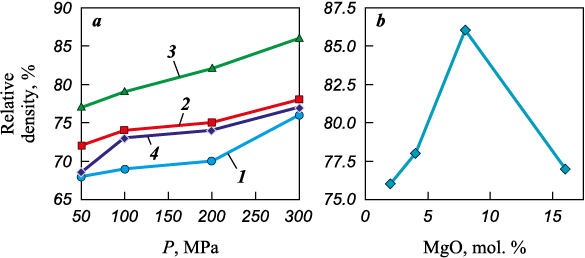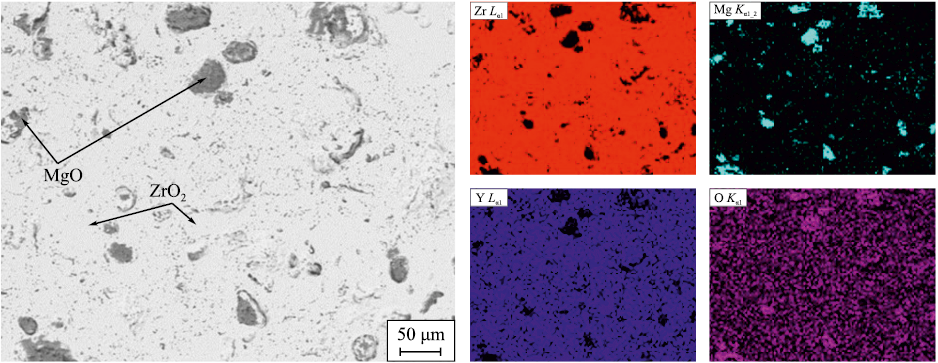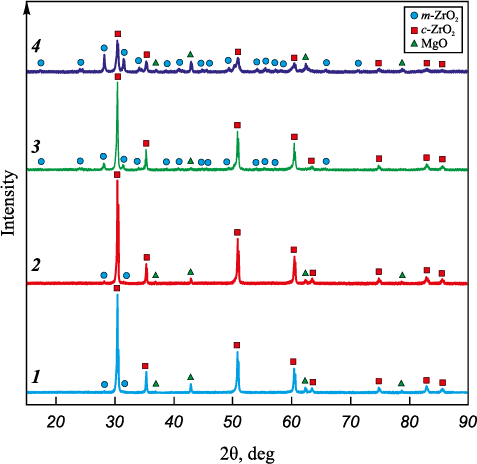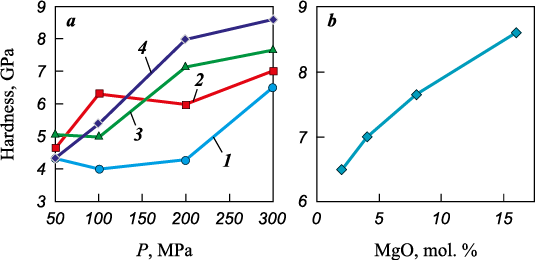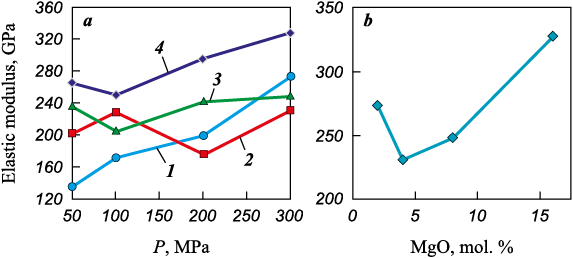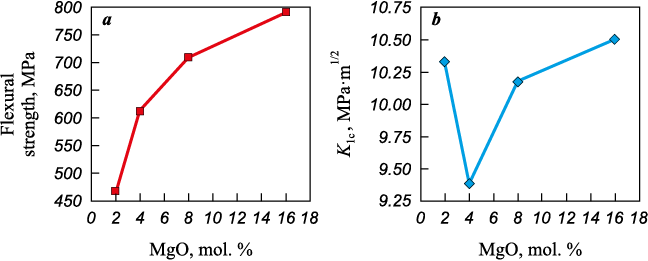Scroll to:
Effect of magnesium oxide on the microstructure and mechanical properties of yttria-stabilized zirconia-based ceramics
https://doi.org/10.17073/1997-308X-2025-3-39-47
Abstract
In the present work, sintering and investigation of composite ceramic materials based on nanostructured MgO–ZrO2 powders were carried out. Zirconium dioxide was additionally stabilized with 3 mol. % yttrium oxide. The nanopowders were pre-treated by mechanical activation using a planetary ball mill at a rotation frequency of 10 Hz. Zirconium dioxide balls were used as the grinding media. The prepared powders were compacted at pressing pressures of 50, 100, 200, and 300 MPa. The compacts were sintered in a high-temperature furnace at 1700 °C. Microstructural studies were performed on the polished surfaces of the sintered samples using scanning electron microscopy (SEM). EDX mapping was conducted to determine the elemental distribution, confirming the presence of two phases in all samples. To evaluate the effectiveness of stabilizing additives on the polymorphic transformation of zirconium dioxide, X-ray diffraction (XRD) analysis was performed. The porosity of the materials and its dependence on the pressing pressure and magnesium oxide content were also assessed. Mechanical properties such as Martens hardness and elastic modulus were measured using a NanoIndenter G200, while flexural strength was evaluated by scratch testing on the same device. Fracture toughness was determined by the indentation method using the Marshall–Evans approach. The influence of magnesium oxide additives on the physical and mechanical properties of the MgO–ZrO2 composite ceramics was established.
Keywords
For citations:
Kuzmenko E.D., Matrenin S.V., Nassyrbayev A.R. Effect of magnesium oxide on the microstructure and mechanical properties of yttria-stabilized zirconia-based ceramics. Powder Metallurgy аnd Functional Coatings (Izvestiya Vuzov. Poroshkovaya Metallurgiya i Funktsional'nye Pokrytiya). 2025;19(3):39-47. https://doi.org/10.17073/1997-308X-2025-3-39-47
Introduction
Zirconium dioxide-based ceramics have found wide application in various fields of science and technology due to their outstanding properties. This material exhibits high fracture toughness [1], low coefficient of friction [2], and significant wear resistance and strength [3]. For this reason, zirconium dioxide-based ceramic materials are widely used in dentistry [4], as well as in the production of hip joint head implants, cutting tools, bearing rolling elements, heat-resistant components, and many other applications.
However, due to the phase transformation of zirconium dioxide into the monoclinic phase and the associated volumetric changes, a number of limitations arise in the manufacturing of components from this material [5]. In particular, the introduction of stabilizing additives is required – most commonly yttrium, calcium, or cerium oxides. The addition of stabilizers makes it possible to prevent the phase transformation by forming a substitutional solid solution based on zirconium dioxide and the introduced additive. The ionic radius of the substituting elements is close to that of (Zr 4+), but slightly larger [6].
The prevention of the phase transformation can also be achieved by other means, in cases where the components do not form solid solutions. One such method is the stabilization by creating a composite material based on Al2O3–ZrO2 . Due to the high elastic modulus of aluminum oxide and its lower thermal expansion, sintering results in a rigid matrix in which zirconium dioxide particles are uniformly distributed and subjected to a compressive stress field. As a result, zirconium dioxide does not undergo polymorphic transformation, and the composite structure enables improved mechanical properties [7]. Magnesium oxide, silicon nitride, and other high-modulus inclusions can also serve as the matrix material [8].
Zirconium dioxide stabilization can be achieved by the combined effect of several factors. However, complex oxide systems consisting of three or more ceramic oxide components have not yet been sufficiently studied. For example, in [9], the effect of small additions (up to 2 wt. %) of MgO on ZTA–CeO2 ceramics was evaluated. It was found that the relationship between the additive and the resulting mechanical properties is nonlinear, with optimal values observed at 0.5 wt. % MgO. This was explained by the formation of two new phases – MgAl11CeO19 and MgAl2O4 . In [10], it was noted that increasing the magnesium oxide content up to 8 mol. % enhances fracture toughness while reducing hardness. In [11], the addition of yttrium oxide to Mg–PSZ ceramics resulted in a noticeable increase in hardness with only a slight decrease in fracture toughness. These studies indicate significant potential for developing composite ceramics based on zirconium dioxide with magnesium and yttrium oxide additives.
The objective of this study was to determine the effect of magnesium oxide content on the microstructure and mechanical properties of ceramics in a complex oxide system: MgO–ZrO2–Y2O3 .
Materials and methods
In this study, nanostructured zirconium dioxide powders of grade UDPO VTU 4-25-90 produced by plasma chemical synthesis (with an average particle size of 500 nm) and industrial-grade micron-sized magnesium oxide powders of grade MRTU 6-09-3391-67 (particle size <40 μm) were used. The purity of both powders was 99 %.
A 3 mol. % yttrium oxide additive was introduced into the zirconium dioxide powder. Based on these powders, mixtures with the following compositions (mol. %) were prepared: 2MgO–98ZrO2 ; 4MgO–96ZrO2 ; 8MgO–92ZrO2 ; 16MgO–84ZrO2 . The compositions of these mixtures in molar and mass percentages are presented in Table.
Composition of powder mixtures
| |||||||||||||||
The powders under investigation were pre-treated by mechanical activation. Mechanical activation was carried out in an Activator-2SL planetary ball mill (Activator Machine-Building Plant, Novosibirsk, Russia) under the following conditions: grinding vessel rotation frequency – 10 Hz, treatment time – 10 min, and a grinding media to powder mass ratio of 3:1. Zirconium dioxide balls were used as grinding media.
The prepared powder mixtures were compacted using carboxymethyl cellulose as a plasticizer at uniaxial pressing pressures of 50, 100, 200, and 300 MPa. The green compacts were then sintered in a high-temperature furnace at 1700 °C with a 1 h dwell time at the target temperature. The densities of the sintered samples were determined using the hydrostatic weighing method. Since the formation of a composite structure with possible new solid solutions complicates the determination of theoretical density, porosity was evaluated based on micrographs of the sample surfaces obtained by scanning electron microscopy (SEM) at low magnification (200×), following the procedure described in [12; 13].
SEM investigations of the sample surfaces and elemental analysis (EDX mapping) were carried out using a Zeiss EVO 50 scanning electron microscope (Carl Zeiss, Germany).
The phase composition of the materials was studied by X-ray diffraction (XRD) using a Shimadzu XRD-7000 diffractometer (Japan) with CuKα1 radiation (λ = 1.5406 Å) and step scanning in the 2θ range of 10–90°. Diffraction peak identification was performed using the Crystallographica Search-Match software and the PDF4+ structural database. The structural analysis was conducted using the PowderCell 2.4 program and the same database.
The mechanical properties of the sintered samples were evaluated using a NanoIndenter G200 (KLA-Tencor, USA) equipped with a Berkovich diamond tip under a 500 mN load. Martens hardness and elastic modulus were determined from the loading curves. Scratch testing was used to determine the flexural strength of the samples under indentation. This method involves scratching the sample surface under a linearly increasing load up to 10 mN, followed by measurement of the crack depth and width. The nanoindentation procedure is described in detail in [14; 15]. Fracture toughness was determined using a Vickers microhardness tester PMT-3 (LOMO JSC, St. Petersburg, Russia) by the indentation method [16]. Cracks were induced under a 5 N load.
Results and discussion
After sintering under the specified conditions, high-density samples were obtained (Fig. 1). Among the studied compositions, the samples with 8MgO–92ZrO2 exhibited the highest density. It was found that the dependence of the relative density of MgO–ZrO2 composite ceramics on composition is nonlinear. At all investigated compaction pressures, the relative densities of the sintered samples decreased in the following order (mol. %): 8MgO–92ZrO2 , 4MgO–96ZrO2 , 16MgO–84ZrO2 , 2MgO–98ZrO2 , which is consistent with the findings reported in [17; 18]. It was shown in [17] that increasing the sintering time for the 8MgO–92ZrO2 ceramic composition leads to a further increase in density, continuing up to 20 h of treatment. In [18], it was noted that the porosity of MgO–ZrO2-based composites varies depending on the presence of magnesium oxide; however, this dependence differs across temperature ranges, exhibiting both an increase and a decrease in material porosity. Moreover, a linear trend was observed only within specific temperature intervals. The study in [18] was conducted at higher temperatures than the present work and reported elevated porosity levels in the range of 24 to 32 %. These findings highlight the effectiveness of the mechanical activation parameters applied in this study and suggest its further use when working with materials of this composition.
Fig. 1. Dependence of the relative density of sintered samples on pressing pressure (a) |
Using EDX mapping to determine the elemental composition of ceramic samples compacted at a pressure of 300 MPa, images of the polished cross-sectional surfaces were obtained. Fig. 2 shows the elemental distribution and microstructure images for the 2MgO–98ZrO2 composition.
Fig. 2. Elemental analysis of a sintered sample with the composition 2MgO–98ZrO2 |
Based on the results of EDX mapping of MgO–ZrO2-based samples, the presence of two distinct phases – MgO and ZrO2 – was established, which is consistent with the observations reported in [19]. However, according to [10; 11; 20], the formation of a solid solution based on ZrO2–MgO should occur. The two-phase composite structure obtained in this study indicates that no interaction between MgO and ZrO2 takes place during sintering. According to the EDX mapping results, magnesium does not enter the crystalline structure of ZrO2 and does not form a solid solution based on ZrO2–MgO, which is attributed to the stabilizing effect of Y2O3 .
To assess the effect of stabilizing additives, XRD analysis was performed (Fig. 3). It was found that zirconium dioxide in the studied samples exists in both the cubic and monoclinic phases, indicating an incomplete stabilization process of zirconium dioxide [10; 21; 22]. According to [23], increasing the sintering temperature should have a positive effect on the stabilization process, which represents a relevant direction for further research.
Fig. 3. X-ray diffraction (XRD) analysis |
Mechanical tests showed that the hardness values of the investigated samples varied over a wide range. The highest Martens hardness (8.65 GPa) was recorded for the ceramic with the composition 16MgO–84ZrO2 , fabricated under a pressing pressure of 300 MPa. At this pressure, all samples exhibited their maximum hardness. An increase in hardness was generally observed with increasing pressing pressure; however, for the 4MgO–96ZrO2 composition, values deviating from this positive trend were identified.
For the MgO–ZrO2 ceramic composite materials, it was found that at a pressing pressure of 50 MPa, the hardness values of the investigated samples were approximately the same across all compositions, around 5 GPa. As the pressing pressure increased, the hardness also increased; however, a distinct contribution of magnesium oxide to the hardness enhancement became apparent only at pressures above 200 MPa. This effect is attributed to the reduced influence of porosity at a pressing pressure of ≥200 MPa, a linearly increasing dependence of hardness on the magnesium oxide content was observed (Fig. 4), which is associated with changes in the crystallochemical structure. A similar trend of increasing hardness with higher MgO content was also reported in [18]. Although the authors of [18] used higher sintering temperatures (from 1570 to 1970 K), our results demonstrate that even at lower sintering temperatures, magnesium oxide retains its positive effect on material hardness, which highlights the potential of this ceramic composite material for further study at reduced sintering temperatures. At the same time, according to [10; 11], the hardness values of the investigated MgO–ZrO2–Y2O3 materials exceed those of MgO–ZrO2 , Y2O3–ZrO2 , and MgO ceramics. For example, the Vickers hardness of MgO–ZrO2–Y2O3 ceramics can reach 14.8 GPa, compared to the respective values of 10.9, 12.0–12.5, and 10–11 GPa reported for the above-mentioned materials.
Fig. 4. Dependence of Martens hardness of sintered samples on pressing pressure (a) |
During the study of the elastic modulus of the materials, the highest value – 330.3 GPa – was recorded for the ceramic with the composition 16MgO–84ZrO2 at a pressing pressure of 300 MPa (Fig. 5). For the MgO–ZrO2 ceramics, the elastic modulus values deviated from the previously observed trend for hardness. For the 4MgO–96ZrO2 and 8MgO–92ZrO2 samples, a nonlinear dependence of the elastic modulus on the applied pressure was observed; however, this property was nearly identical at both the maximum and minimum pressures. Across all applied pressures, the highest elastic modulus was found for the 16MgO–84ZrO2 composition. At a pressing pressure of 50 MPa, it was observed that the elastic modulus increased with increasing magnesium oxide content. However, with further increases in pressing pressure, this dependence broke down and became nonlinear, no longer associated with porosity levels. It was found that at the highest pressing pressure and maximum material density, the ceramics with compositions 16MgO–84ZrO2 and 2MgO–98ZrO2 exhibited the highest elastic moduli, while the compositions 4MgO–96ZrO2 and 8MgO–92ZrO2 showed lower values. In other words, a parabolic dependence of the elastic modulus on the magnesium oxide content is formed, with a minimum at 4 mol. % MgO. Study [25] presents the dependence of the elastic modulus on the MgO content in MgO–ZrO2 composites and shows an increase in modulus up to 20 mol. % MgO. At higher MgO contents, the elastic modulus decreases. However, since the increments of magnesium oxide addition in that study were large (about 20 %), they did not provide sufficient resolution to describe the influence of MgO on the elastic modulus in the 0–20 % range. Therefore, the present study is of particular relevance, as it reveals the behavior of the elastic modulus within this critical composition interval.
Fig. 5. Dependence of elastic modulus of sintered samples on pressing pressure (a) |
In this study, the strength parameters of ceramic samples obtained at a pressing pressure of 300 MPa were determined using the scratch test method, along with the critical stress intensity factors (fracture toughness) (Fig. 6). It was found that the lowest strength (467.17 MPa) was exhibited by the sample with the composition 2MgO–98ZrO2 . An increase in strength was observed with rising magnesium oxide content, reaching up to 791.15 MPa, with this trend following a hyperbolic pattern. According to [25], the behavior of the strength parameter, similar to that of the elastic modulus, reaches a maximum upon the addition of 20 mol. % MgO, followed by a decline when this content is exceeded, assuming the same fixed intervals of magnesium oxide addition.
Fig. 6. Dependence of flexural strength (а) and fracture toughness (b) |
In the present study, it was found that the fracture toughness (critical stress intensity factor) varies nonlinearly with increasing magnesium oxide content, reaching a maximum value of 10.53 MPa·m1/2 with the composition 16 mol. % MgO. Publications [9; 10] report that the introduction of magnesium oxide in various molar fractions increases the fracture toughness of zirconia-based ceramics; however, the dependence is nonlinear. According to [9], the addition of a small amount of magnesium oxide – 0.5 mol. % MgO – raises the fracture toughness to 9.14 MPa·m1/2. In publication [10], zirconia samples stabilized with 8 mol. % MgO were studied. The authors [10] found that increasing the sintering temperature from 1450 to 1500 °C led to an increase in the critical stress intensity factor from 7.59 to 8.5 MPa·m1/2. In the present work, raising the sintering temperature to 1700 °C and introducing an additional stabilizing additive – yttrium oxide – resulted in an increase in fracture toughness to 10.14 MPa·m1/2 for the sample containing 8 mol. % MgO, which indicates the effectiveness of sintering temperature enhancement for improving this parameter.
Conclusions
1. The conducted study established that the consolidation of MgO–ZrO2 ceramic powder mixtures with additional stabilization of zirconium dioxide using yttrium oxide enables the formation of a composite structure. It was shown that magnesium does not enter the crystal structure of ZrO2 and does not form a ZrO2–MgO-based solid solution due to the stabilizing effect of Y2O3 .
2. Mechanical activation of the ceramic batches at a rotation frequency of 10 Hz for 10 min resulted in a reduction in the porosity of the sintered materials compared to previously reported data.
3. It was found that increasing the pressing pressure to 300 MPa has a positive effect on the mechanical properties of the materials.
4. Among the investigated samples, the highest Martens hardness (8.65 GPa) was observed for the ceramic with a composition of 16MgO–84ZrO2 obtained at a pressing pressure of 300 MPa. An increase in the magnesium oxide content has a positive effect on the hardness of the material; however, a significant contribution of MgO to the improvement in hardness is observed only at P > 200 MPa, which is associated with a reduced contribution of porosity to the resulting hardness.
5. The sample with a composition of 16MgO–84ZrO2 obtained at a pressing pressure of 300 MPa exhibited the highest elastic modulus among all tested materials – 330.3 GPa. This composition demonstrated the highest elastic modulus values at all applied pressing pressures. For the samples obtained at P = 300 MPa, a parabolic dependence of the elastic modulus on magnesium oxide content was revealed, with a minimum at 4 mol. % MgO.
6. It was found that increasing the magnesium oxide content leads to higher tensile strength, reaching 791.15 MPa at 16 mol. % MgO.
7. It was shown that the dependence of the critical stress intensity factor on magnesium oxide content is nonlinear, with a maximum value of 10.53 MPa·m1/2 at 16 mol. % MgO.
References
1. Soon G., Pingguan-Murphy B., Lai K.W., Akbar S.A. Review of zirconia-based bioceramic: Surface modification and cellular response. Ceramics International. 2016; 42(11):12543–12555. https://doi.org/10.1016/j.ceramint.2016.05.077
2. Ghaemi M.H., Reichert S., Krupa A., Sawczak M., Zykova A., Lobach K., Svitlychnyi Y. Zirconia ceramics with additions of alumina for advanced tribological and biomedical applications. Ceramics International. 2017; 43(13):9746–9752. https://doi.org/10.1016/j.ceramint.2017.04.150
3. Smirnov V.V., Smirnov S.V., Obolkina T.O., Antonova O.S., Goldberg M.A., Barinov S.M. Low-temperature liquid-phase sintering of zirconium dioxide: study of phase composition and microstructure. Reports of the Russian Academy of Sciences. Chemistry, Materials Science. 2020;494(1);37–41. (In Russ.). https://doi.org/10.31857/S268695352005012X
4. Goldberg M.A., Smirnov V.V., Barinov S.M. Creation of new ceramic materials based on zirconium dioxide and aluminum oxide for medical applications. In: Baikov Institute of Metallurgy and Materials Science of the RAS – 80 years: Collection of scientific articles. Moscow: Interkontakt Nauka, 2018. P. 286–292. (In Russ.). https://doi.org/10.30791/978-5-902063-58-20286-292
5. Hannink R.H.J., Kelly P.M., Muddle B.C. Transformation toughening in zirconia-containing ceramics. Journal of the American Ceramic Society. 2000; 83(3):461–487. https://doi.org/10.1111/j.1151-2916.2000.tb01221.x
6. Casellas D., Cumbrera F.L., Sánchez-Bajo F., Forsling W., Llanes L., Anglada M. On the transformation toughening of Y–ZrO2 ceramics with mixed Y–TZP/PSZ microstructures. Journal of the European Ceramic Society. 2001;21(6):765–777. https://doi.org/10.1016/S0955-2219(00)00273-9
7. Dmitrievskii A.A., Zhigachev A.O., Zhigacheva D.G., Tyurin A.I. Structure and mechanical properties of the CaO–ZrO2–Al2O3 ceramic composites at low corundum concentrations. Technical Physics. 2019;64(1):81–91. https://doi.org/10.1134/S1063784219010092
8. Aragon-Duarte M.C., Nevarez-Rascon A., Esparza-Ponce H.E., Nevarez-Rascon M.M., Talamantes R.P., Ornelas C., Hurtado-Macias A. Nanomechanical properties of zirconia-yttria and alumina zirconia-yttria biomedical ceramics, subjected to low temperature aging. Ceramics International. 2017;43(5):3931–3939. https://doi.org/10.1016/j.ceramint.2016.12.033
9. Rejab N.A., Azhar A.Z., Kian K.S., Ratnam M.M., Ahmad Z.A. Effects of MgO addition on the phase, mechanical properties, and microstructure of zirconia-toughened alumina added with CeO2 (ZTA–CeO2) ceramic composite. Materials Science and Engineering: A. 2014;595:18–24. https://doi.org/10.1016/j.msea.2013.11.091
10. Soylemez B., Sener E., Yurdakul A., Yurdakul H. Fracture toughness enhancement of yttria-stabilized tetragonal zirconia polycrystalline ceramics through magnesia-partially stabilized zirconia addition. Journal of Science: Advanced Materials and Devices. 2020;5(4):527–534. https://doi.org/10.1016/j.jsamd.2020.09.003
11. Chieko Y., Armani P.J. Influence of Y2O3 addition on the microstructure and mechanical properties of Mg–PSZ ceramics. Materials Science and Engineering: A. 2011; 1:556–561.
12. Che T., Mao H.R., Guo R.F., Shen P. Ultrafast synthesis and pressureless densification of multicomponent nitride and carbonitride ceramics. Ceramics International. 2023; 49(19):31530–31538. https://doi.org/10.1016/j.ceramint.2023.07.104
13. Kosyanov D.Yu., Zavjalov A.P., Vornovskikh A.A., Zakharenko A.M., Liu X., Li J. Some approaches for residual porosity estimating. IOP Conference Series: Materials Science and Engineering. 2021;1093(1):12–15. https://doi.org/10.1088/1757-899X/1093/1/012015
14. Kuzmenko E.D. Investigation of physical and mechanical properties and microstructure of ceramics based on zirconium carbide and nitride. In: Proceedings of the XII All Russian scientific conference on current issues of continuum mechanics and celestial mechanics (CICMCM 2023) (Tomsk, Russia, 15–17 November 2023). Springer, Singapore: 2024. Vol. 412. P. 150–157. https://doi.org/10.1007/978-981-97-1872-6_22
15. Matrenin S.V., Mostovshchikov A.V., Mirovoy Yu.A. Study of the structure and physical and mechanical properties of ceramics based on aluminum and zirconium oxynitrides. Bulletin of the Tomsk Polytechnic University. Geo Assets Engineering. 2022;333(2):184–192. (In Russ.). https://doi.org/10.18799/24131830/2022/2/3569
16. Moradkhani A., Panahizadeh V., Hoseinpour M. Indentation fracture resistance of brittle materials using irregular cracks: a review. Heliyon. 2023;9(9):12. https://doi.org/10.1016/j.heliyon.2023.e19361
17. Ahmed Z.S., Chyad F.A. SEM-assisted thermophysical and mechanical properties of sintered MgO–ZrO2 composite. Energy Procedia. 2013;36:872–880. https://doi.org/10.1016/j.egypro.2013.07.100
18. Khakhalkin V.V., Kulkov S.N. Effect of hot pressing temperature on the phase composition and crystal structure parameters of the highly dispersed ZrO2–MgO powder system. Perspektivnye Materialy. 2010;(2):98–102. (In Russ.).
19. Song Q., Zha X., Gao M., Shi J., Ma Y. Influence of ZrO2 on the phase composition and mechano-physical properties of MgO–ZrO2 refractories prepared by cold isostatic pressing. Ceramics International. 2024;50(17):30474–30482. https://doi.org/10.1016/j.ceramint.2024.05.345
20. Sniezek E., Szczerba J., Stoch P., Prorok R., Jastrzebska I., Bodnar W., Burkel E. Structural properties of MgO–ZrO2 ceramics obtained by conventional sintering, arc melting and field assisted sintering technique. Materials & Design. 2016;99:412–420. https://doi.org/10.1016/j.matdes.2016.03.106
21. Rada S., Zhang J., Rada R., Culea E. Advanced zirconia ceramics stabilized with yttria and magnesia: Structure and Vickers microhardness. Journal of the Mechanical Behavior of Biomedical Materials. 2022;134:105425. https://doi.org/10.1016/j.jmbbm.2022.105425
22. Abdelgawad M., El-Gamal S.M.A., Ewais E.M., Li S. Effect of magnesia rich spinel on densification and stabilization behavior of monoclinic zirconia. Journal of the Korean Ceramic Society. 2021;58:276–286. https://doi.org/10.1016/j.jmbbm.2022.105425
23. Jiang L., Guo S., Bian Y., Zhang M., Ding W. Effect of sintering temperature on mechanical properties of magnesia partially stabilized zirconia refractory. Ceramics International. 2016;42(9):10593–10598. https://doi.org/10.1016/j.ceramint.2016.03.136
24. Kuzmenko E.D., Matrenin S.V., Nassyrbayev A.R. Physical and mechanical properties of ceramics based on ZrN–ZrO2 obtained by spark plasma sintering method. Bulletin of the Tomsk Polytechnic University. Geo Assets Engineering. 2024;335(7):166–173. (In Russ.). https://doi.org/10.18799/24131830/2024/7/4614
25. Tkachev D.A., Buyakov A.S. Study of strength properties of porous composite ZrO2(MgO)–MgO under three-point bending. In: Actual problems of modern mechanics of continuous media and celestial mechanics. Tomsk: TSU, 2018. P. 154–158. (In Russ.).
About the Authors
E. D. KuzmenkoRussian Federation
Egor D. Kuzmenko – Student, Division for Materials Science, School of Advanced Manufacturing Technologies
30 Lenin Prosp., Tomsk 634050, Russia
S. V. Matrenin
Russian Federation
Sergey V. Matrenin – Cand. Sci. (Eng.), Associate Professor, Division for Materials Science, School of Advanced Manufacturing Technologies
30 Lenin Prosp., Tomsk 634050, Russia
A. R. Nassyrbayev
Russian Federation
Artur R. Nassyrbayev – Assistant, Division for Power and Electrical Engineering, School of Energy & Power Engineering
30 Lenin Prosp., Tomsk 634050, Russia
Review
For citations:
Kuzmenko E.D., Matrenin S.V., Nassyrbayev A.R. Effect of magnesium oxide on the microstructure and mechanical properties of yttria-stabilized zirconia-based ceramics. Powder Metallurgy аnd Functional Coatings (Izvestiya Vuzov. Poroshkovaya Metallurgiya i Funktsional'nye Pokrytiya). 2025;19(3):39-47. https://doi.org/10.17073/1997-308X-2025-3-39-47




